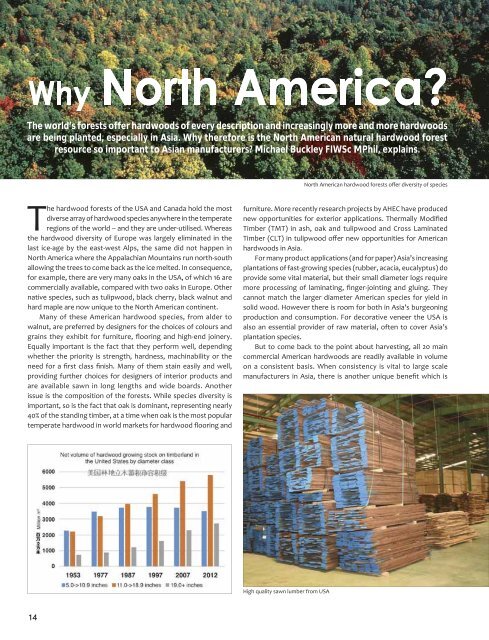American Hardwood Supplement 2018
Published in collaboration with the American Hardwood Export Council, this publication brings to light the latest updates and activities of US hardwood suppliers within the South East Asia region.
Published in collaboration with the American Hardwood Export Council, this publication brings to light the latest updates and activities of US hardwood suppliers within the South East Asia region.
You also want an ePaper? Increase the reach of your titles
YUMPU automatically turns print PDFs into web optimized ePapers that Google loves.
AMERICAN HARDWOOD Southeast Asia <strong>Supplement</strong> <strong>2018</strong><br />
The world’s forests offer hardwoods of every description and increasingly more and more hardwoods<br />
are being planted, especially in Asia. Why therefore is the North <strong>American</strong> natural hardwood forest<br />
resource so important to Asian manufacturers? Michael Buckley FIWSc MPhil, explains.<br />
North <strong>American</strong> hardwood forests offer diversity of species<br />
The hardwood forests of the USA and Canada hold the most<br />
diverse array of hardwood species anywhere in the temperate<br />
regions of the world – and they are under-utilised. Whereas<br />
the hardwood diversity of Europe was largely eliminated in the<br />
last ice-age by the east-west Alps, the same did not happen in<br />
North America where the Appalachian Mountains run north-south<br />
allowing the trees to come back as the ice melted. In consequence,<br />
for example, there are very many oaks in the USA, of which 16 are<br />
commercially available, compared with two oaks in Europe. Other<br />
native species, such as tulipwood, black cherry, black walnut and<br />
hard maple are now unique to the North <strong>American</strong> continent.<br />
Many of these <strong>American</strong> hardwood species, from alder to<br />
walnut, are preferred by designers for the choices of colours and<br />
grains they exhibit for furniture, flooring and high-end joinery.<br />
Equally important is the fact that they perform well, depending<br />
whether the priority is strength, hardness, machinability or the<br />
need for a first class finish. Many of them stain easily and well,<br />
providing further choices for designers of interior products and<br />
are available sawn in long lengths and wide boards. Another<br />
issue is the composition of the forests. While species diversity is<br />
important, so is the fact that oak is dominant, representing nearly<br />
40% of the standing timber, at a time when oak is the most popular<br />
temperate hardwood in world markets for hardwood flooring and<br />
furniture. More recently research projects by AHEC have produced<br />
new opportunities for exterior applications. Thermally Modified<br />
Timber (TMT) in ash, oak and tulipwood and Cross Laminated<br />
Timber (CLT) in tulipwood offer new opportunities for <strong>American</strong><br />
hardwoods in Asia.<br />
For many product applications (and for paper) Asia’s increasing<br />
plantations of fast-growing species (rubber, acacia, eucalyptus) do<br />
provide some vital material, but their small diameter logs require<br />
more processing of laminating, finger-jointing and gluing. They<br />
cannot match the larger diameter <strong>American</strong> species for yield in<br />
solid wood. However there is room for both in Asia’s burgeoning<br />
production and consumption. For decorative veneer the USA is<br />
also an essential provider of raw material, often to cover Asia’s<br />
plantation species.<br />
But to come back to the point about harvesting, all 20 main<br />
commercial <strong>American</strong> hardwoods are readily available in volume<br />
on a consistent basis. When consistency is vital to large scale<br />
manufacturers in Asia, there is another unique benefit which is<br />
High quality sawn lumber from USA<br />
14


















